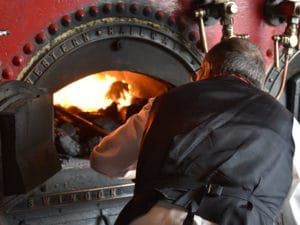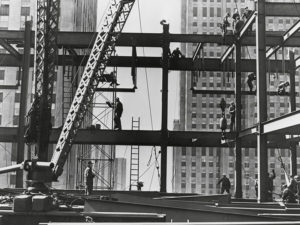The history of asbestos
Find out about the history of asbestos, when it was discovered and how it was used.2500 BC – 700 BC:
 First recorded uses of asbestos date as far back as 2500 BC during the new stone age. Archaeological findings in many locations throughout the world show that asbestos was first used during this time period. The main usage of asbestos during the new stone age was as a temper or strengthener for ceramics. Asbestos rock was mined and crushed by hand. This released the asbestos fibre which was then added to whatever material needed to be strengthened.
First recorded uses of asbestos date as far back as 2500 BC during the new stone age. Archaeological findings in many locations throughout the world show that asbestos was first used during this time period. The main usage of asbestos during the new stone age was as a temper or strengthener for ceramics. Asbestos rock was mined and crushed by hand. This released the asbestos fibre which was then added to whatever material needed to be strengthened. 700 BC – 500 AD
The ancient Greeks and Egyptians are known to have used asbestos in many applications. These include wicks for candles and for cloth to carry out mummification. The ancient Greeks were the first to have recorded the low thermal conductivity of asbestos and its resistance to fire and acids.
 Historical records show that asbestos fibre was used for items such as shrouds, napkins, tablecloths, and special purpose clothing. As mining asbestos was very time consuming it was regarded as a very expensive and rare natural wonder.
Historical records show that asbestos fibre was used for items such as shrouds, napkins, tablecloths, and special purpose clothing. As mining asbestos was very time consuming it was regarded as a very expensive and rare natural wonder.
Asbestos was a name given to this mineral by the Greeks. Asbestos in ancient Greek means inextinguishable. The name asbestos was adopted and continued to be used by the west. In addition to the Greeks and Egyptians many other places in the world including China and India were actively using asbestos fibre.
During the age of the Roman Empire, it was the Romans who first recorded the potential health effects from inhaling asbestos fibre. The Romans used asbestos for a variety of purposes. They would clean asbestos cloth by exposing it to fire. The asbestos cloth would remain undamaged and come out of the fire clean and white. The Romans called asbestos “amiantus”, meaning unpolluted.
500 AD – 1500 AD
 During the middle age’s asbestos became even more popular. Experiments with asbestos were being undertaken and its usage expanded. Asbestos was woven into cloth lining for suits of armour. It was used to make paper for writing. The wealthy used asbestos for textiles and similar applications.
During the middle age’s asbestos became even more popular. Experiments with asbestos were being undertaken and its usage expanded. Asbestos was woven into cloth lining for suits of armour. It was used to make paper for writing. The wealthy used asbestos for textiles and similar applications.
Marco Polo recorded seeing asbestos mining and many asbestos materials during his travels in Asia. King Charlemagne was recorded to have used asbestos fibre for tablecloths and garments. Towards the end of the middle ages the use of asbestos appeared to decline, until the start of the industrial revolution.
1700 – 1900

During the mid-1800’s entrepreneurs recognised that asbestos could make them rich. Mining became more advanced reducing the cost of asbestos. Many asbestos factories across the UK opened and mass production of asbestos containing materials started. Asbestos was regarded as a miracle material which could be used for almost anything. Asbestos became low price and readily available.
1900 – 2000
 In early 1900 asbestos building and construction products became very popular. Mass usage of asbestos in buildings began. During the first world war 1914 – 1918 asbestos was extensively used in ship and other military vehicle building. Towards the end of the first world war it was observed in several studies that asbestos workers were dying at unnaturally young ages. The first diagnosis of Asbestosis was in 1924. Further studies undertaken on asbestos workers showed that 25% of workers had asbestos related lung disease.
In early 1900 asbestos building and construction products became very popular. Mass usage of asbestos in buildings began. During the first world war 1914 – 1918 asbestos was extensively used in ship and other military vehicle building. Towards the end of the first world war it was observed in several studies that asbestos workers were dying at unnaturally young ages. The first diagnosis of Asbestosis was in 1924. Further studies undertaken on asbestos workers showed that 25% of workers had asbestos related lung disease.
Laws were gradually introduced to try and eradicate asbestos related deaths. These included the first UK asbestos regulations which were released in 1931. Despite all of this, the construction industry continued to use asbestos in very large quantities. This was mainly due to it being far more cost effective than other products.
During the 1940’s through to the end of the 1970’s and 1980’s asbestos usage in the UK was at its highest. Virtually every building that was constructed or refurbished right up until the year 2000 had asbestos building and construction materials installed. Asbestos was also widely used during these periods outside of the construction industry and could be found in everything ranging from cosmetics, fertilizers, hair dryers, irons through to cigarette filters. Towards the end of 1999 and at the start of 2000 the UK officially banned the import and usage of asbestos.
2000 – Now & The Future
 It is worthy of note that although the UK banned the usage of asbestos at the start of 2000 the rest of the world did not follow suit. Asbestos is still mined and used in a large percentage of countries. Just two of those countries, China and Russia still mine and export over 990,000 million metric tonnes of asbestos which is used around the world. Although the import and usage of asbestos in the UK was banned the health effects from asbestos remain the single biggest cause of work-related death in the UK.
It is worthy of note that although the UK banned the usage of asbestos at the start of 2000 the rest of the world did not follow suit. Asbestos is still mined and used in a large percentage of countries. Just two of those countries, China and Russia still mine and export over 990,000 million metric tonnes of asbestos which is used around the world. Although the import and usage of asbestos in the UK was banned the health effects from asbestos remain the single biggest cause of work-related death in the UK.
This is due to the sheer amount of asbestos used within the construction industry over a period of 100 years. Over 6 million tonnes of asbestos was imported into the UK. On an average mix with other materials at a rate of 50% this would calculate to over 12 million tonnes of asbestos containing materials being used within construction in the UK.
The asbestos removal and surveying industry in the UK has grown year on year for the last 40 years and is currently an estimated £7.5 billion pound a year industry. It has been estimated that asbestos removal and surveying work will continue in the UK for another 100 years and beyond. The risk from asbestos is very much with us and will be long into the future.

 "There are lots of guarantees around. Here's my simple guarantee: If there's something wrong, we'll fix it."
Jess Scott - CEO
"There are lots of guarantees around. Here's my simple guarantee: If there's something wrong, we'll fix it."
Jess Scott - CEO

















